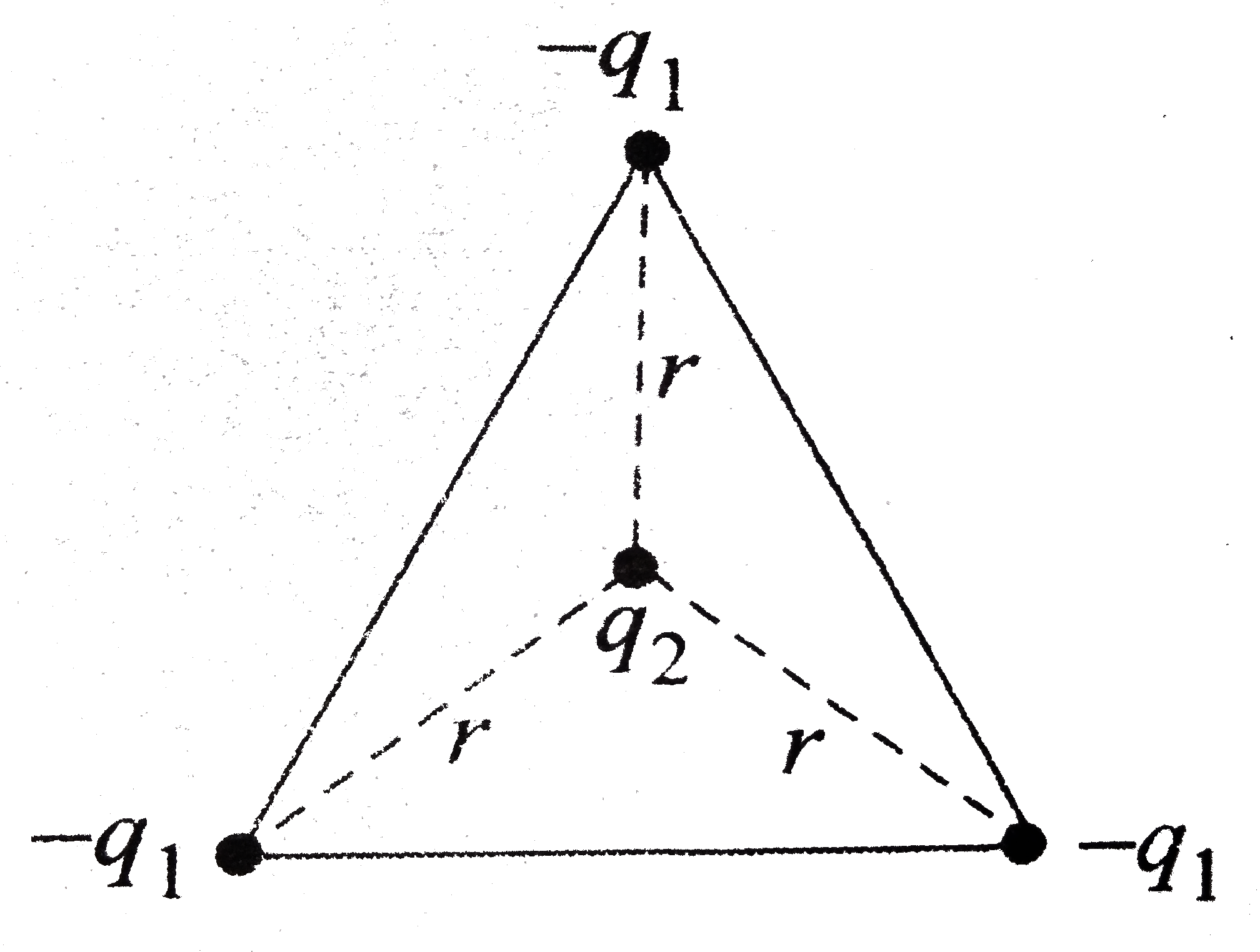A particle of mass m carrying a charge −q1 starts moving around a fixed charge +q2 along a circulare path of radius r. Find the time period of revolution T of charge −q1.
To find the time period of revolution T of the charge −q1 moving in a circular path around the fixed charge +q2, we can follow these steps:
Step 1: Identify the forces acting on the charge
The charge −q1 experiences a centripetal force due to the electrostatic attraction towards the fixed charge +q2. According to Coulomb's law, the electrostatic force F between the two charges is given by:
F=k|q1||q2|r2
where k is Coulomb's constant.
Step 2: Relate the electrostatic force to centripetal force
For the charge −q1 to move in a circular path, the electrostatic force must provide the necessary centripetal force. The centripetal force Fc required for circular motion is given by:
Fc=mv2r
where m is the mass of the particle and v is its speed.
Step 3: Set the forces equal
Setting the electrostatic force equal to the centripetal force, we have:
k|q1||q2|r2=mv2r
Step 4: Solve for the speed v
Rearranging the equation to solve for v2:
k|q1||q2|=mv2⋅r
v2=k|q1||q2|m⋅1r
Taking the square root gives us the speed v:
v=√k|q1||q2|mr
Step 5: Find the time period T
The time period T of revolution is given by the formula:
T=2πrv
Substituting the expression for v:
T=2πr√k|q1||q2|mr
Step 6: Simplify the expression for T
This can be simplified:
T=2πr⋅√mrk|q1||q2|
T=2π√mr3k|q1||q2|
Final Result
Thus, the time period of revolution T is:
T=2π√mr3k|q1||q2|
The charge −q1 experiences a centripetal force due to the electrostatic attraction towards the fixed charge +q2. According to Coulomb's law, the electrostatic force F between the two charges is given by:
For the charge −q1 to move in a circular path, the electrostatic force must provide the necessary centripetal force. The centripetal force Fc required for circular motion is given by:
Setting the electrostatic force equal to the centripetal force, we have:
Rearranging the equation to solve for v2:
The time period T of revolution is given by the formula:
This can be simplified:
Thus, the time period of revolution T is:
Topper's Solved these Questions
- COULOMB LAW AND ELECTRIC FIELDBook:CENGAGE PHYSICS ENGLISHChapter:COULOMB LAW AND ELECTRIC FIELDExercise:Subjective Type
Explore 15 Videos
- COULOMB LAW AND ELECTRIC FIELDBook:CENGAGE PHYSICS ENGLISHChapter:COULOMB LAW AND ELECTRIC FIELDExercise:Subjective
Explore 32 Videos
- COULOMB LAW AND ELECTRIC FIELDBook:CENGAGE PHYSICS ENGLISHChapter:COULOMB LAW AND ELECTRIC FIELDExercise:Solved examples
Explore 10 Videos
- CENGAGE PHYSICS DPPBook:CENGAGE PHYSICS ENGLISHChapter:CENGAGE PHYSICS DPPExercise:subjective type
Explore 51 Videos
- ELECTRIC CURRENT & CIRCUITSBook:CENGAGE PHYSICS ENGLISHChapter:ELECTRIC CURRENT & CIRCUITSExercise:Kirchhoff s law and simple circuits
Explore 15 Videos
Similar Questions
A particle of mass m carrying charge '+q1' is revolving around a fixed charge '−q2' in a circular path of radius r. Calculate the period of revolution.
View SolutionCharge q2 of mass m revolves around a stationary charge q1 in a circulare orbit of radius r. The orbital periodic time of q2 would be
View Solution
Knowledge Check
The work done in carrying a charge q once round a circle of radius r with a charge Q at the centre is
AqQ4πε0aBqQ4πε0a2Cq4πε0aDzero
A particle of mass m and charge -q circulates around a fixed charge q in a circle radius under electrostatic force. The total energy of the system is (k= (14πε0))
View SolutionA particle having charge + q is fixed at a point O and a second particle of mass m and having charge −q0 moves with constant speed in a circle of radius r about the charge +q. the energy required to be supplied to the moving charge to increase radius of the path to 2r is qq0nπε0r. Find the value of n.
View SolutionA particle of mass m and having charge q is moving in a circular path of radius r in the presence of a uniform magnetic field. The particle breaks into smaller fragments X and Y of equal mass. The fragment X now has charge q3 and the fragment Y has charge 2q3. Immediately after the fragmentation, X comes to rest. The radius of the path of Y is now rY. The ratio rYr is ______________.
View SolutionA pendulum of length L carries a negative charge - q on the bob. A positive charge +q is held at the point of support . Then, the time period of the bob is
View SolutionA charged particle of mass m and charge q travels on a circular path of radius r that is perpendicular to a magnetic field B. The time takeen by the particle to complete one revolution is
View SolutionA particle of mass m and charge q is located midway between two fixed charged particles each having a charge q and a distance 2l apart. Prove that the motion of the particle will be SHM if it is displaced slightly along the line connecting them and released. Also find its time period.
View SolutionThree equal negative charges, −q1 each form the vertices of and equilateral triangle . A particle of mass m and a positive charge q2 is constrained to move along a line perpendicular to the plane of triangle and through its center, which at a distance r from each of the negative charges as shown in fig. The whole systen is kept in gravity-free space, Find the time period of vibration of the particle for small displacement from the equilibrium position.

View Solution